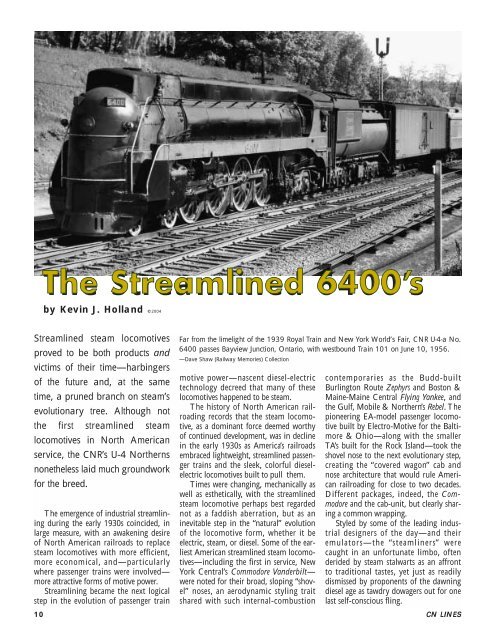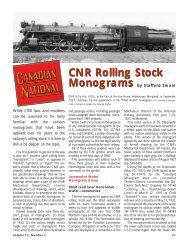CN LINES V12N3 - Canadian National Railways Historical Association
CN LINES V12N3 - Canadian National Railways Historical Association
CN LINES V12N3 - Canadian National Railways Historical Association
You also want an ePaper? Increase the reach of your titles
YUMPU automatically turns print PDFs into web optimized ePapers that Google loves.
The Streamlined 6400’s<br />
by Kevin J. Holland © 2004<br />
Streamlined steam locomotives<br />
proved to be both products and<br />
victims of their time—harbingers<br />
of the future and, at the same<br />
time, a pruned branch on steam’s<br />
evolutionary tree. Although not<br />
the first streamlined steam<br />
locomotives in North American<br />
service, the <strong>CN</strong>R’s U-4 Northerns<br />
nonetheless laid much groundwork<br />
for the breed.<br />
The emergence of industrial streamlining<br />
during the early 1930s coincided, in<br />
large measure, with an awakening desire<br />
of North American railroads to replace<br />
steam locomotives with more efficient,<br />
more economical, and—particularly<br />
where passenger trains were involved—<br />
more attractive forms of motive power.<br />
Streamlining became the next logical<br />
step in the evolution of passenger train<br />
Far from the limelight of the 1939 Royal Train and New York World’s Fair, <strong>CN</strong>R U-4-a No.<br />
6400 passes Bayview Junction, Ontario, with westbound Train 101 on June 10, 1956.<br />
—Dave Shaw (Railway Memories) Collection<br />
motive power—nascent diesel-electric<br />
technology decreed that many of these<br />
locomotives happened to be steam.<br />
The history of North American railroading<br />
records that the steam locomotive,<br />
as a dominant force deemed worthy<br />
of continued development, was in decline<br />
in the early 1930s as America’s railroads<br />
embraced lightweight, streamlined passenger<br />
trains and the sleek, colorful dieselelectric<br />
locomotives built to pull them.<br />
Times were changing, mechanically as<br />
well as esthetically, with the streamlined<br />
steam locomotive perhaps best regarded<br />
not as a faddish aberration, but as an<br />
inevitable step in the “natural” evolution<br />
of the locomotive form, whether it be<br />
electric, steam, or diesel. Some of the earliest<br />
American streamlined steam locomotives—including<br />
the first in service, New<br />
York Central’s Commodore Vanderbilt—<br />
were noted for their broad, sloping “shovel”<br />
noses, an aerodynamic styling trait<br />
shared with such internal-combustion<br />
contemporaries as the Budd-built<br />
Burlington Route Zephyrs and Boston &<br />
Maine-Maine Central Flying Yankee, and<br />
the Gulf, Mobile & Northern’s Rebel. The<br />
pioneering EA-model passenger locomotive<br />
built by Electro-Motive for the Baltimore<br />
& Ohio—along with the smaller<br />
TA’s built for the Rock Island—took the<br />
shovel nose to the next evolutionary step,<br />
creating the “covered wagon” cab and<br />
nose architecture that would rule American<br />
railroading for close to two decades.<br />
Different packages, indeed, the Commodore<br />
and the cab-unit, but clearly sharing<br />
a common wrapping.<br />
Styled by some of the leading industrial<br />
designers of the day—and their<br />
emulators—the “steamliners” were<br />
caught in an unfortunate limbo, often<br />
derided by steam stalwarts as an affront<br />
to traditional tastes, yet just as readily<br />
dismissed by proponents of the dawning<br />
diesel age as tawdry dowagers out for one<br />
last self-conscious fling.<br />
10 <strong>CN</strong> <strong>LINES</strong>



